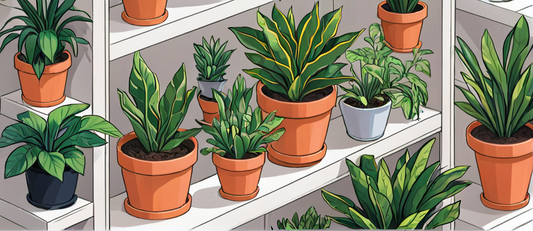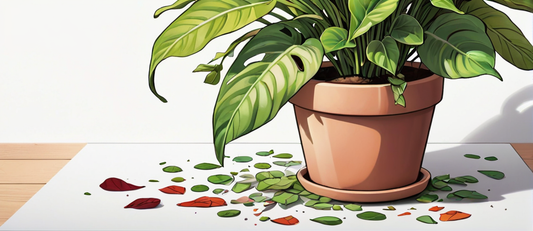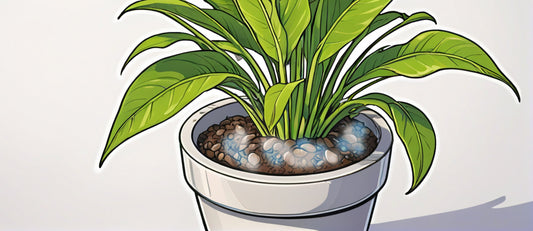

Can you bring a dying Indoor Plant back to life?
Indoor Plant Care | Plant Health
Quick AnswerPlant feeling a bit under the weather? Don't panic! It's often possible to give your leafy pal a new lease of life. First, play detective – is it too much sun, not enough water, or maybe some pesky bugs? Once you've cracked the case, you can sort things out – a change of spot, a good drink, or perhaps even a fresh pot of soil. With a bit of TLC, your plant could be back to its blooming best!
There's nothing more heartbreaking than seeing your beloved Indoor Plants struggling. Leaves turning weird colours, drooping, or even dropping off... it's enough to make any plant parent panic. But don't worry – many common plant problems are fixable! With the right care, you can get your leafy friend back to its lush, beautiful self.
Step 1: Plant CSI - What's Wrong?
Take a good look at your plant. Ask yourself:
- What Kind of Damage? Yellow leaves? Brown spots? Drooping? Each symptom points to different possible causes.
- Bug Hunt: Any signs of pests? Webbing between leaves, sticky residue, or tiny insects could mean your plant has unwanted visitors.
- Soil Check: Is the soil waterlogged, or so dry it cracks? Root problems are often caused by improper watering
- Environment: Is the plant near a draughty window, or blasting radiator? Sudden temperature changes can stress plants out.
Step 2: Watering Woes (The #1 Plant Killer)
Nine times out of ten, plant problems come down to watering. Here's how to know if it's too much, too little, or just right:
- Overwatering:
- Yellow leaves + soggy soil is a dead giveaway. The roots are literally drowning!
- What to do: Very gently ease the plant out of the pot. Any mushy, smelly roots need to be snipped off. Repot with fresh, well-draining soil. Let it dry out properly before you water again.
- Underwatering:
- Think of a shrivelled prune! Crispy, droopy leaves + bone-dry soil means your plant is desperately thirsty.
- What to do: Soak the whole pot in a sink or tub of water for an hour. This rehydrates the soil properly. Let it drain thoroughly, then start checking the soil more often so it doesn't get so dry again.
- Goldilocks Watering: You want the soil to be just moist. Stick your finger in – if it's dry down to the first knuckle, it's time to water!
Step 3: Light Matters
Is your plant getting the right amount of light for its type?
- Not Enough:
- Stretching towards the window, or new growth being smaller & paler than normal, means it needs more light.
- Slowly increase the light it gets – moving it too fast can shock it. A grow light can be a lifesaver if your home is on the dim side.
- Too Much:
- Scorched, crispy, or bleached-looking leaves – especially those facing the light – are a sunburn sign.
- Move it into a shadier spot. Sheer curtains help filter the strongest rays, or try a spot a few feet back from the window.
Step 4: Pest Patrol
Time to check for these common houseplant hitchhikers:
- Spider Mites: Tiny red specks (often on the undersides of leaves) and fine webbing are tell-tale signs. These sap-suckers weaken your plant quickly.
- Mealybugs: White fluffy blobs, usually tucked into nooks and crannies. Seriously gross, and they damage plants fast.
- Scale: These look like little brown bumps on leaves and stems. Easy to overlook, but they can cause serious problems if left to multiply.
- Aphids: Tiny green, black, or white bugs, often on new growth. They leave behind sticky "honeydew" secretions that can attract other pests and diseases
Pest Solutions:
- Mild Cases: A strong shower knocks lots of bugs off. Repeat every few days until they're gone.
- Neem oil or insecticidal soap work well, but follow the instructions carefully!
- Get the sick plant away from your healthy ones to stop the spread
- Bad Infestation? Ask at your local garden centre for advice – sometimes stronger products are needed
Step 5: Time for Some TLC
A bit of pampering can help your plant bounce back:
- Pruning: Snip off dead or badly damaged bits with sharp scissors. This helps the plant focus its energy on new growth.
- Repotting: If the pot is too small, or the soil looks old and clumpy, it's time!
- Slightly bigger pot with drainage holes is crucial
- Fresh potting mix – make sure it's the right kind for your plant. Many popular houseplants need a special blend for good drainage.
- Fertiliser: Think of this as vitamins for your plant. A weak dose of balanced liquid fertiliser during the growing season helps your plant recover (but don't overdo it!).
Don't Give Up Hope!
Plants are amazingly resilient. Even if you lose a few leaves, or have to cut it back quite hard, it can often come back stronger than ever. Remember:
- Early action is key! The sooner you fix the problem, the better your plant's chances
- A Little Patience Goes a Long Way: Plants don't always bounce back overnight. Keep giving it good care, and you'll likely see new growth soon.



